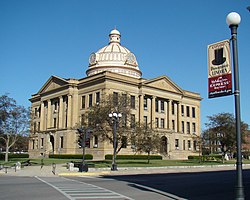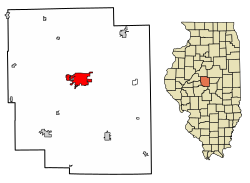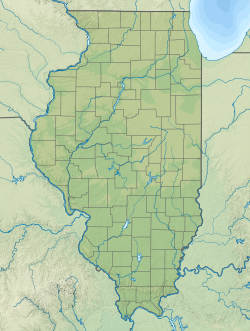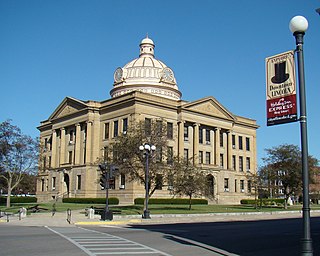
Logan County is a county located in the U.S. state of Illinois. According to the 2020 census, it had a population of 27,987. Its county seat is Lincoln.
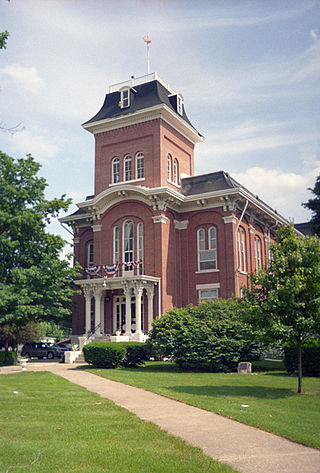
Iroquois County is a county located in the northeast part of the U.S. state of Illinois. According to the 2020 United States Census, it has a population of 27,077. It is the only county in the United States to be named Iroquois, after the American Indian people. The county seat is Watseka. The county is located along the border with Indiana.

Jackson County is a county located in the U.S. state of Illinois with a population of 52,974 at the 2020 census. Its county seat is Murphysboro, and its most populous city is Carbondale, home to the main campus of Southern Illinois University. The county was incorporated on January 10, 1816, and named for Andrew Jackson. The community of Brownsville served as the fledgling county's first seat.

Bond County is a county located in the U.S. state of Illinois. As of the 2020 census, the population was 16,725. Its county seat is Greenville.

Marshall is a city in and the county seat of Clark County, Illinois, United States, located approximately 20 miles (32 km) west of Terre Haute, Indiana. The population was 3,947 at the 2020 census.

Carthage is a city in and the county seat of Hancock County, Illinois, United States. Its population was 2,490 as of the 2020 census. Carthage is best known for being the site of the 1844 death of Joseph Smith, who founded the Latter Day Saint movement.

Dallas City is a city in Hancock and Henderson counties in the U.S. state of Illinois. The population in 2020 stands at an estimate of 805, a decline from the 2010 census of 945, which was a decline from 1,055 in 2000.

Mendota is a city in LaSalle County, Illinois, United States, in the state's north-central region. The population was 7,061 at the 2020 census. It is part of the Ottawa, IL Micropolitan Statistical Area. Mendota is located approximately 85 miles west of Chicago, 70 miles east of Moline and 55 miles south of Rockford. The current mayor is David W. Boelk, an independent elected to a four-year term.

Pontiac is a city in and the county seat of Livingston County, Illinois, United States. The population was 11,150 in the 2020 census. The 1984 movie Grandview, U.S.A. was set in Pontiac.

Broadwell is a village in Logan County, Illinois, United States. The population was 136 at the 2020 census.

Elkhart is a village in Logan County, Illinois, United States. The population was 405 at the 2010 census.

Macomb is a city in and the county seat of McDonough County, Illinois, United States. It is situated in western Illinois, about 75 miles (121 km) southwest of Peoria. As of the 2020 census the population of the city was 15,051, down from 19,288 in 2010. Macomb is the home of Western Illinois University.

Lexington is a city in McLean County, Illinois, United States. The population was 2,090 at the 2020 census. There are two theories regarding the etymology of the city name. One says it was named for the Battle of Lexington, where General Gridley's father fought. and the other that it was named for the home town of James Brown, the town's co-founder.
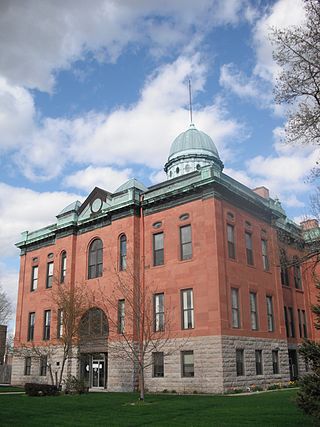
Petersburg is a city in and the county seat of Menard County, Illinois, United States, on the bluffs and part of the floodplain overlooking the Sangamon River. It is part of the Springfield, Illinois Metropolitan Statistical Area. The population was 2,258 at the 2020 census, nearly unchanged from 2010. Petersburg is located approximately 2 miles (3 km) north of New Salem, the original location where Abraham Lincoln first settled, as he started his career.
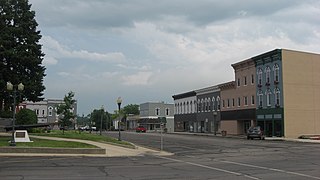
Sullivan is a city in Moultrie County, Illinois, United States. The population was 4,413 at the time of the 2020 census. It is the county seat and largest city of Moultrie County. Sullivan is named after Sullivan's Island, South Carolina, where Fort Moultrie is located.
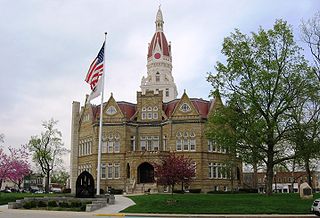
Pittsfield is a city in and the county seat of Pike County, Illinois, United States. The population was 4,576 at the 2010 census, an increase from 4,211 in 2000.
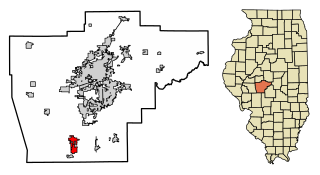
Auburn is a city in Sangamon County, Illinois, United States. The population was 4,771 at the 2010 census, and 4,681 in 2018. It is part of the Springfield, Illinois Metropolitan Statistical Area.

Stanford is a home rule-class city in Lincoln County, Kentucky, United States. It is one of the oldest settlements in Kentucky, having been founded in 1775. Its population was 3,487 at the 2010 census and an estimated 3,686 in 2018. It is the county seat of Lincoln County. Stanford is part of the Danville Micropolitan Statistical Area.
The Postville Courthouse State Historic Site is a replica county courthouse in Lincoln, Illinois, United States. The original frame courthouse was built in 1840 and later moved to Greenfield Village in Michigan; the current courthouse, which is a close replica of the first, was built in 1953. The building's unusual history is derived from its status as one of the courthouses used by lawyer Abraham Lincoln as he traveled the circuit of courtrooms in central Illinois. The courthouse replica is operated by the Illinois Historic Preservation Agency.

Lincoln station is an Amtrak train station in Lincoln, Illinois, United States, at Broadway and Chicago Streets. Service is provided by Lincoln Service and the Texas Eagle. The current station is the rail line's former freight depot, renovated in 2017. Adjacent to the current station structure is a brick Spanish Mission-style depot building, constructed in 1911 by the former Chicago and Alton Railroad and later used by the Gulf, Mobile and Ohio Railroad. Although no longer used by Amtrak, the historic 1911 depot has been renovated for commercial use. During the 1980s and 1990s it served dually as a railroad station and restaurant.
